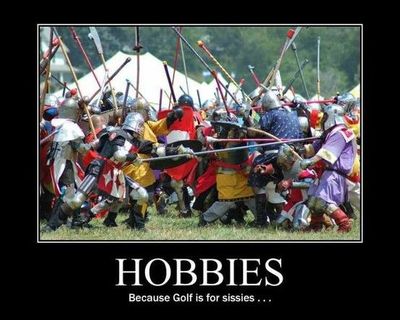
Pennsic War starts today. At 9 am Eastern Time, the flood gates open and I will be standing in the breach, my first year as a “general”. I am in charge of troll. If you want to check-in, you go through me and my staff. (Needless to say, I have prepped this posting in advance.)
Worldbuilding, whether creating a world through writing or through digging dirt and setting up tents, needs to be done on multiple layers. For Pennsic, it isn’t enough to buy a modern tent and show up. You need garb and money, food and equipment. And once everything is set up, learning, fighting, friends, and stories. Layers upon layers.
When writing about warcraft, the layers are also needed, especially in the fantasy and science fiction setting. Historic game-changers for war have included the spear, the bow, the stirrup, gunpowder, tanks, and missiles. Each modified strategy and logistics. Fog and rain negates long-distance weaponry. Mud negates heavy objects like horses and tanks. High ground, low ground. Water, food, heat, cold, distance, troops. Each impact a battle.
What happens when magic is added to the mix? How would scientific advancements adjust tactics? Could plain-old weather and landscape negate the fantastic science and magic? What worldbuilding is needed to make a magical world at war be real?
Fantasy Faction explores this in “Worlds within Worlds – Part Three: Magic Warfare“. Having lived through and in a (reenacted) medieval mud and war environment, I have some different ideas than are presented here. No mention is made of fortifications, and the magical enhancements to said fortifications. I seriously doubt the wizards would be the group leaders, more like specialists within a group, since they will be too busy casting to keep track of the battle around them. The healers in the backlines would be major targets, like the supply depots are today, though hard to reach.
And mud. Mud is a thing. I am so hoping this year will be a dry year for Pennsic. Though dust is also a thing. Dust and camp fire smog. The haze burns the eyes. So a little rain once every other day would be nice. But even a little rain means mud when you got 5,000 warriors on a field. Basically war is mud and dust no matter what and I will be living in it for three weeks. Checking in other crazy people for this worldbuilding of war exercise.
Read the article to see how layers can be added through worldbuilding: http://fantasy-faction.com/2017/worlds-within-worlds-part-two-magic-warfare
DAY-OF NOTE – It is a wet Pennsic … rain every day for three weeks is predicted. Scattered showers so around 10-20 minutes per day. Result will mean not as much dust … lots more mud. Clay mud resulting in “slick” in the hard pack areas; deep, boot-sucking fens in the grassy areas.
WRITING EXERCISE: If you are writing a fantasy or science fiction story, think about one of the defining magics/scientific advances of your story. Apply it to a battle situation, guerrilla or traditional. Where would changes occur: supply lines, medical units, food, mobility, communication, hand-to-hand, and distance? Take one of the changes and expand on how it would affect an officer, a grunt, and a civilian who lives near the battlefield.
***
A laser pistol. The beam goes until it hits something, then burns a hole – instantly vaporizing the material.
“until it hits something” – Missing is bad. The beam continues until it disperses. At this time we have home tools which can measure as far as 660 feet, about a tenth of a mile. Let’s say the laser pistol is has an effective TIGHT range of 0.1 miles and disbursement stops somewhere around triple that.
The radius of the hole is very limited, which means it needs to hit a particular spot on a human being to kill them (sniper) or go right through them. Sniper accuracy in battle is pretty bad, so it needs to be a borer – go through about a foot of human flesh.
Not a weapon one would like to use on a spaceship or in close-combat where the troops are mixed up.
The upside medically is the laser self-cauterizes resulting in less bleed-outs; if the wound isn’t fatal, the injured party can keep fighting. The downside medically is the self-cauterization means that wound is basically permanent. Dead flesh, whatever is left after the vaporization, all the way through. The medical staff would need to remove the burned, destroyed flesh as part of the treatment, significantly increasing the tissue damage.
First thing people are going to do is create an armor to deflect the damage. Armor adds heat and weight to soldiers. Face grills will be required, because even diffuse lasers will be nasty to the eyes at three-tenths of a mile, which will restrict vision – a requirement on the battlefield. Likely a full helmet will result, restricting breathing and being very nasty for when sick.
The grunt would prefer a splatter weapon with a shorter range, three-tenths of a mile is too big. Too much a chance of friendly fire downrange. The armor and full helmet will annoy and be horrific in hot environments, but the grunt will wear it anyway because getting hit pretty much mean limb or organ loss since medical ain’t got nothing to fix after its been vaporized. Thank the skynet for cyberparts, right?
Officers will train snipers and also need to set protection against being sniped.
The civilian will need to get out of the way. In urban warfare the range of the weapons is five blocks. I can’t even see that far. No hiding in the house from a weapon good at penetrating a foot of material. And out in open fields, lie down in a rut like a tornado is about to go over.
On Sunday, look for the flash “Wounds”, inspired by this writing exercise.